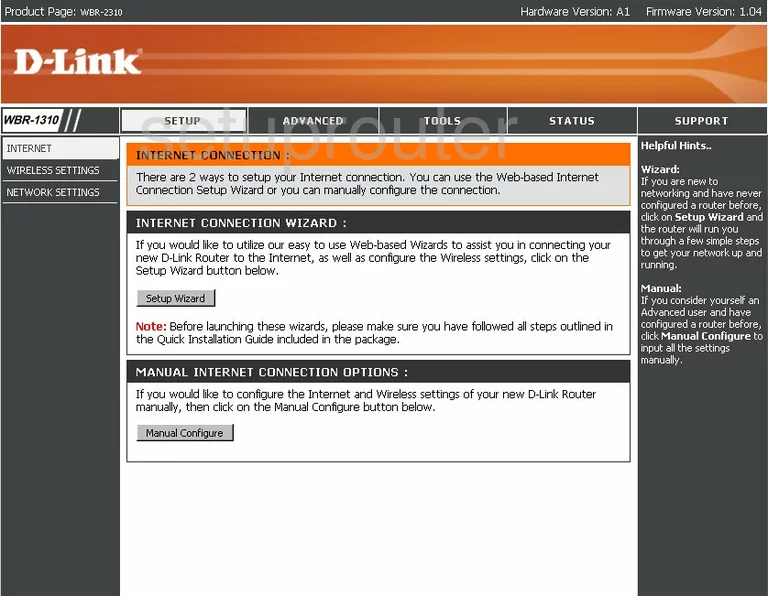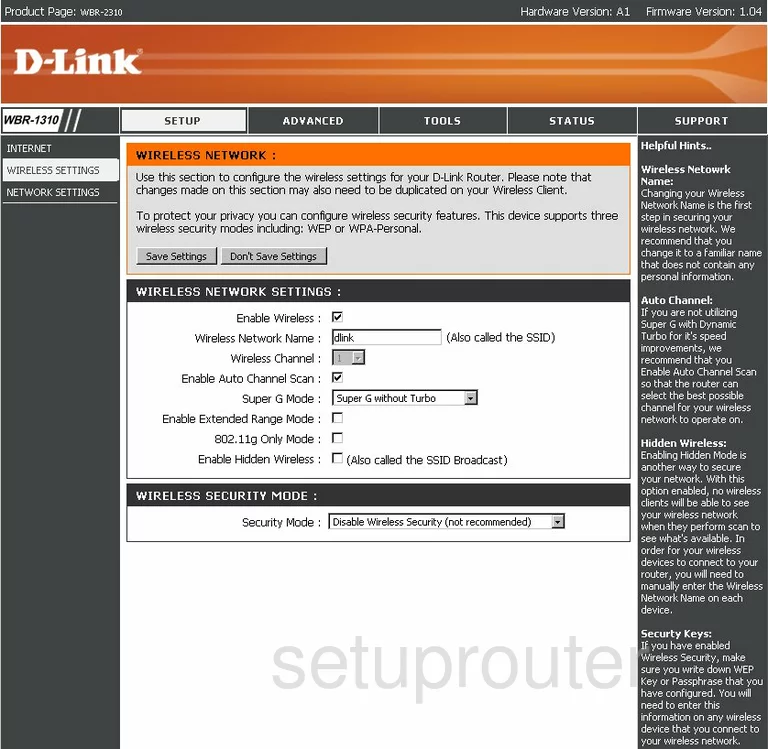The Dlink WBR-2310 router is considered a wireless router because it offers WiFi connectivity. WiFi, or simply wireless, allows you to connect various devices to your router, such as wireless printers, smart televisions, and WiFi enabled smartphones.
Other Dlink WBR-2310 Guides
This is the wifi guide for the Dlink WBR-2310. We also have the following guides for the same router:
- Dlink WBR-2310 - How to change the IP Address on a Dlink WBR-2310 router
- Dlink WBR-2310 - Dlink WBR-2310 User Manual
- Dlink WBR-2310 - Dlink WBR-2310 Login Instructions
- Dlink WBR-2310 - How to Reset the Dlink WBR-2310
- Dlink WBR-2310 - Information About the Dlink WBR-2310 Router
- Dlink WBR-2310 - Dlink WBR-2310 Screenshots
- Dlink WBR-2310 v2 - How to change the IP Address on a Dlink WBR-2310 router
- Dlink WBR-2310 v2 - Dlink WBR-2310 User Manual
- Dlink WBR-2310 v2 - Dlink WBR-2310 Login Instructions
- Dlink WBR-2310 v2 - Setup WiFi on the Dlink WBR-2310
- Dlink WBR-2310 v2 - How to Reset the Dlink WBR-2310
- Dlink WBR-2310 v2 - Information About the Dlink WBR-2310 Router
- Dlink WBR-2310 v2 - Dlink WBR-2310 Screenshots
WiFi Terms
Before we get started there is a little bit of background info that you should be familiar with.
Wireless Name
Your wireless network needs to have a name to uniquely identify it from other wireless networks. If you are not sure what this means we have a guide explaining what a wireless name is that you can read for more information.
Wireless Password
An important part of securing your wireless network is choosing a strong password.
Wireless Channel
Picking a WiFi channel is not always a simple task. Be sure to read about WiFi channels before making the choice.
Encryption
You should almost definitely pick WPA2 for your networks encryption. If you are unsure, be sure to read our WEP vs WPA guide first.
Login To The Dlink WBR-2310
To get started configuring the Dlink WBR-2310 WiFi settings you need to login to your router. If you are already logged in you can skip this step.
To login to the Dlink WBR-2310, follow our Dlink WBR-2310 Login Guide.
Find the WiFi Settings on the Dlink WBR-2310
If you followed our login guide above then you should see this screen.

You begin on the Setup page of the Dlink WBR-2310 router. To configure the WiFi settings, click the link in the left sidebar labeled WIRELESS SETTINGS.
Change the WiFi Settings on the Dlink WBR-2310

You are then directed to a page like the one you see here.
- Change the Wireless Network Name. This is also sometimes referred to as the SSID. This is the name you give your network so that you can identify it later on. It doesn't matter what you enter here so long as it is memorable for you. Do not use personal information. If you want to learn more about the SSID, read our Wireless Names Guide.
- Next is the Wireless Channel. This can be changed just like a radio or television channel. You need to be on a non-overlapping channel. There is only room in the WiFi spectrum for up to three channels that do not overlap, 1,6, and 11. Be sure you are using one of these three channels. To learn more about this, read our WiFi Channels Guide. To change the channel, you may first need to uncheck the box titled Enable Auto Channel Scan then choose a channel from the Wireless Channel drop down menu.
- Now find the Security Mode. There are several different choices here and if you want to know the differences, check out our guide titled WEP vs. WPA. Our recommendation is the option of Enable WPA2 Wireless Security (enhanced).
- Some new options should now appear. In the drop down menu of Cipher Type you can choose between TKIP, AES, or AUTO. Our recommendation is the newest form of encryption, AES.
- Next to PSK/EAP, select the option of PSK.
- The Passphrase is next. This is the password you are to use to gain or grant access to your local network. We recommend using at least 14 characters in this password. This password should contain at least one number and symbol along with the letters you use. The more random a password looks, the stronger it is. To learn more about creating a strong and memorable password, read our Choosing a Strong Password Guide.
- Confirm this password by retyping it in the Confirmed Passphrase box.
- Click the Save Settings option near the top of the page to save your changes.
Congratulations, you are done.
Possible Problems when Changing your WiFi Settings
After making these changes to your router you will almost definitely have to reconnect any previously connected devices. This is usually done at the device itself and not at your computer.
Other Dlink WBR-2310 Info
Don't forget about our other Dlink WBR-2310 info that you might be interested in.
This is the wifi guide for the Dlink WBR-2310. We also have the following guides for the same router:
- Dlink WBR-2310 - How to change the IP Address on a Dlink WBR-2310 router
- Dlink WBR-2310 - Dlink WBR-2310 User Manual
- Dlink WBR-2310 - Dlink WBR-2310 Login Instructions
- Dlink WBR-2310 - How to Reset the Dlink WBR-2310
- Dlink WBR-2310 - Information About the Dlink WBR-2310 Router
- Dlink WBR-2310 - Dlink WBR-2310 Screenshots
- Dlink WBR-2310 v2 - How to change the IP Address on a Dlink WBR-2310 router
- Dlink WBR-2310 v2 - Dlink WBR-2310 User Manual
- Dlink WBR-2310 v2 - Dlink WBR-2310 Login Instructions
- Dlink WBR-2310 v2 - Setup WiFi on the Dlink WBR-2310
- Dlink WBR-2310 v2 - How to Reset the Dlink WBR-2310
- Dlink WBR-2310 v2 - Information About the Dlink WBR-2310 Router
- Dlink WBR-2310 v2 - Dlink WBR-2310 Screenshots